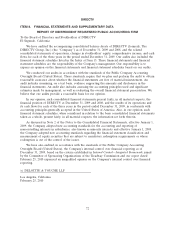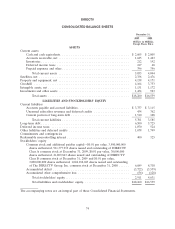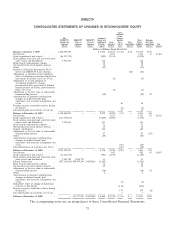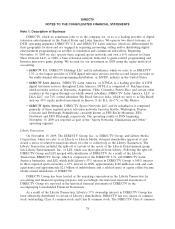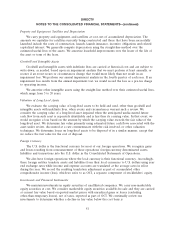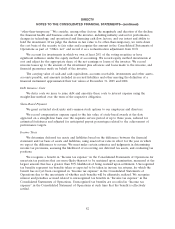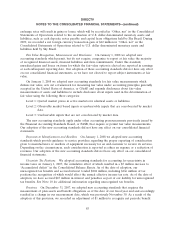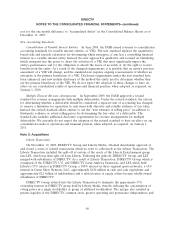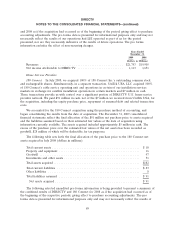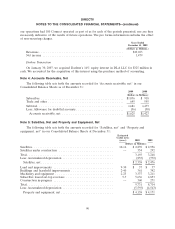DIRECTV 2009 Annual Report Download - page 94
Download and view the complete annual report
Please find page 94 of the 2009 DIRECTV annual report below. You can navigate through the pages in the report by either clicking on the pages listed below, or by using the keyword search tool below to find specific information within the annual report.DIRECTV
NOTES TO THE CONSOLIDATED FINANCIAL STATEMENTS—(continued)
‘‘other-than-temporary.’’ We consider, among other factors: the magnitude and duration of the decline;
the financial health and business outlook of the investee, including industry and sector performance,
changes in technology, and operational and financing cash flow factors; and our intent and ability to
hold the investment. If we judge the decline in fair value to be other-than-temporary, we write-down
the cost basis of the security to fair value and recognize the amount in the Consolidated Statements of
Operations as part of ‘‘Other, net’’ and record it as a reclassification adjustment from OCI.
We account for investments in which we own at least 20% of the voting securities or have
significant influence under the equity method of accounting. We record equity method investments at
cost and adjust for the appropriate share of the net earnings or losses of the investee. We record
investee losses up to the amount of the investment plus advances and loans made to the investee, and
financial guarantees made on behalf of the investee.
The carrying value of cash and cash equivalents, accounts receivable, investments and other assets,
accounts payable, and amounts included in accrued liabilities and other meeting the definition of a
financial instrument approximated their fair values at December 31, 2009 and 2008.
Debt Issuance Costs
We defer costs we incur to issue debt and amortize these costs to interest expense using the
straight-line method over the term of the respective obligation.
Share-Based Payment
We grant restricted stock units and common stock options to our employees and directors.
We record compensation expense equal to the fair value of stock-based awards at the date
approved on a straight-line basis over the requisite service period of up to three years, reduced for
estimated forfeitures and adjusted for anticipated payout percentages related to the achievement of
performance targets.
Income Taxes
We determine deferred tax assets and liabilities based on the difference between the financial
statement and tax basis of assets and liabilities, using enacted tax rates in effect for the year in which
we expect the differences to reverse. We must make certain estimates and judgments in determining
income tax provisions, assessing the likelihood of recovering our deferred tax assets, and evaluating tax
positions.
We recognize a benefit in ‘‘Income tax expense’’ in the Consolidated Statements of Operations for
uncertain tax positions that are more-likely-than-not to be sustained upon examination, measured at the
largest amount that has a greater than 50% likelihood of being realized upon settlement. Unrecognized
tax benefits represent tax benefits taken or expected to be taken in income tax returns, for which the
benefit has not yet been recognized in ‘‘Income tax expense’’ in the Consolidated Statements of
Operations due to the uncertainty of whether such benefits will be ultimately realized. We recognize
interest and penalties accrued related to unrecognized tax benefits in ‘‘Income tax expense’’ in the
Consolidated Statements of Operations. Unrecognized tax benefits are recorded in ‘‘Income tax
expense’’ in the Consolidated Statement of Operations at such time that the benefit is effectively
settled.
82


